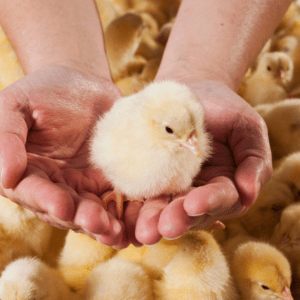 Raising chicks can be super rewarding. It’s really fun but you need the right tools and knowledge to do it right. Making sure they have a safe and comfy place is key for their growth and health. Here’s your guide to the essential tools for successful chicken brooding.
Raising chicks can be super rewarding. It’s really fun but you need the right tools and knowledge to do it right. Making sure they have a safe and comfy place is key for their growth and health. Here’s your guide to the essential tools for successful chicken brooding.
Selecting the Right Brooder Box
Your chicks will spend their first weeks in a brooder box. It’s important it’s big enough for them to move comfortably. It should have high walls so they can’t get out. You could use a cardboard box, a plastic tote, or even a wooden crate. The brooder also needs to fit a heat source and space for food and water without being too crowded.
The brooder box should be easy to clean. Lining it with newspapers or paper towels helps with quick daily cleanups. This keeps your chicks healthy and cuts down disease risks. Cleaning the brooder regularly is a must to keep things hygienic. A clean brooder stops harmful bacteria from growing and keeps your chicks safe.
Providing Adequate Heat Source
Chicks need steady warmth to stay warm. Most folks use a heat lamp for this. Make sure it’s set up safely above the brooder. It shouldn’t be too close because you don’t want to overheat the chicks. You might be asking, “How long do chicks need a heatlamp?” Usually, they need it until they’re about 6-8 weeks old or until they’ve got all their feathers. You can reduce the heat gradually as they grow, helping them get used to the outside temps.
Keep an eye on the temp with a thermometer. Start at about 95°F in the first week. Then, drop it by 5°F each week until they’re ready to go outside. Move the lamp up or down to adjust the temperature. Getting the temperature right is super important for their comfort and growth.
Pro Tip: Chicks that are too hot will pant and make noise to try to lose heat so that’s a sign to reduce the intensity of the heat source.
Ensuring Clean Water Supply
Clean water is crucial for your chicks. It’s best to use a waterer that’s designed for them. This stops spills and keeps their water clean. Place it where the chicks can reach easily but where it won’t get dirty. Make sure the waterer is at the right height so they can drink without struggling.
You should check and refill the water every day. Clean the waterer regularly to avoid algae and bacteria. Keeping the water fresh helps your chicks stay hydrated and healthy. If it gets cold, make sure the water doesn’t freeze by using heated waterers or keeping the brooder warm.
Feeding Your Chicks Properly
Proper die is key for strong chicks. Give them starter feed that’s made just for them. Put it in a shallow dish or a feeder that’s easy for them to get to. Always keep the feeder full of fresh food. A good diet right from the start helps them grow healthy and strong.
Store your feed in a cool, dry place so it doesn’t spoil. Don’t feed your chicks anything moldy or old because it can make them sick. Chicks can’t chew; they need grit to help them digest. Always make sure they have some grit to help break down their food.
Providing Bedding for Comfort
Chicks need bedding for comfort and cleanliness. Pine shavings are good because they absorb well and are easy to change. Don’t use cedar shavings; they’re not good for chicks. Lay down a good layer of bedding in the bottom of the brooder for them to walk on.
Change the bedding often to keep it fresh and dry. This stops infections and keeps the brooder healthy. Fresh bedding is really important for your chicks’ well-being. Changing dirty bedding often stops diseases and makes sure your chicks are comfy.
Ensuring Proper Ventilation
Good air flow is a must to stop moisture and bad smells from building up. Put the brooder in a place with good air but no drafts. Fresh air keeps the environment healthy for the chicks. If there’s not enough ventilation, the air can get stale and harm the chicks.
Use mesh lids or something similar to cover the brooder. This lets air in but keeps the chicks safe. Keep an eye on humidity and adjust the air flow as needed. Good ventilation is important to stop breathing problems and keep overall health up.
Providing Light for Growth
Chicks need good light to do well. Besides the heat lamp, make sure there’s enough normal light in the brooder area. Light helps them grow properly and affects how they act. The right light levels encourage them to be active and help them get used to normal day and night cycles.
In the first week, they need light all day and night. Gradually reduce the light to get them used to natural light patterns. The right light is really important for their development and health.
Keeping Chicks Safe
Keeping your chicks safe is super important. Put the brooder in a safe spot away from pets and wild animals. Make sure all equipment, like the heat lamp, is secure to avoid accidents. Safety first to prevent injuries and keep the chicks safe.
Check on them often to make sure they are doing okay and feeling comfy. Watch for any signs they’re not well and fix any problems fast. A safe and calm environment is key to raising healthy chicks. Regular checks help you spot and sort out issues quickly, keeping your chicks safe and sound.
Doing chicken brooding right means having the right tools and taking proper care of your chicks. From choosing the right brooder to making sure they have clean water, each part is important for their health and growth. By giving them the right heat, air, and safety, you can create a great place for your chicks to grow up. These steps will help you have a fun and rewarding time raising healthy and happy chickens. Giving them the best care from the start builds a strong foundation for their future.


